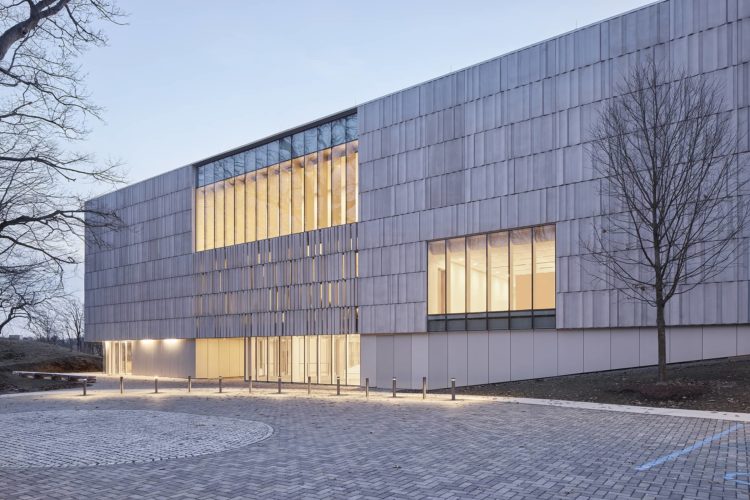
By John Kavanagh
At the April 26 meeting of the Greenwich Retired Men’s Association Steve Myers introduced the speaker, Robert Wolterstorff, executive director of the Bruce Museum, whose topic was “The New Bruce Museum: A World Class Destination for Art, Culture, and Science Education.” Dr. Wolterstorff joined the Bruce in 2019, after a 27-year career in the arts and museum leadership. He has held curatorial and research positions, most recently at the Bennington Museum in Vermont, and earlier at the Philadelphia Museum of Art, the Clark Art Institute, the Williams College Museum of Art and the college’s Chapin Rare Book Library. He served as a trustee for the New England Museum Association from 2006 to 2015. Wolterstorff earned a Master of Fine Arts and a Doctorate in Art History from Princeton University. He has a Master’s in Art History from Williams College and a Bachelor’s degree in biology from Calvin College in Grand Rapids, Michigan. It is fitting that a museum that combines Art and Science should have someone with Dr. Wolterstorff’s diverse background in both these disciplines.
The new Bruce, just opened on April 2nd, has more than doubled the size of the museum, adding 43,000 square feet that features a façade of glass and cast stone, inspired by the striated surfaces of Connecticut’s rock quarries. The centerpiece of the new Bruce is the Richter wing, a three-story, $67MM addition—funded privately by people in the Greenwich community—that is integrated with the current structure. “Today, it’s about a new building, but it’s also about a bigger concept,” says Dr. Wolterstorff. “It’s a new Bruce, a completely re-imagined, re-invented Bruce museum.”
The new Richter Wing provides community spaces and embeds the museum in Bruce Park nature and community as never before. The new main entrance faces Museum Drive and is completely re-oriented to and integrated into the park. The community spaces on the new ground floor, entered from the park, are free to visitors. There is onsite dining for the first time, an expanded Lecture Hall (now 250 seats), a larger Museum Store, and a Conference Room. Science exhibitions and education classrooms have been expanded to entirely occupy the old museum space.
Dr. Wolterstorff’s talk exuded his excitement at finally seeing the museum fully accessible to the public and hosting thousands of visitors. It has opened to rave reviews, including in the New York Times and Wall Street Journal, and is attracting attention from all over the New York to New Haven region. It simply has exceeded expectations.
There are four pillars to the Bruce’s new mission: Community, Art, Science, and Education. All four elements of the mission are served by the new building. The ground floor is entirely community space. The second floor has storage space, a conference room and a wood shop. The third floor consists of five permanent galleries, both art and science together. The galleries house impressionist and modern art, sculptures, a stunning mineral exhibit, and a changing science exhibit, which is currently about penguins. A beautiful wide staircase connects the floors, passes under a Gabriel Dodd creation featuring thousands of beautiful colored threads, and faces an open inner court which provides natural light and a green space.
The education wing is housed in what used to be the front of the old building. The new Bruce does education every day and is drawing students from Fairfield and Westchester Counties. With the expanded classroom space and the new galleries, the Bruce expects to double the number of students educated at museum, from the 26,000 a year that were being served before the pandemic.
Dr. Wolterstorff said that as beautiful as the building is, it is “ultimately a tool to do good work in the world”. He feels that the Bruce expansion will ultimately be judged by how we use the building”. He expressed the view that “We want a noisy, active, busy museum, where people encounter art, science and ideas, and each other.”
The Bruce is a great gift to the Greenwich community, one that we can all enjoy for years to come.
To see the full presentation, go to https://greenwichrma.org, cursor to “Speakers” and click on “Speaker Videos.”
The RMA’s upcoming presentation, “What would Alexis de Tocqueville say about Democracy in America today?” by John Blankley is scheduled for 11 AM on Wednesday, May 10th. John Blankley, RMA member, businessman, entrepreneur, local politician (now retired) will offer thoughts based on his life-long affinity with the earliest, and still foremost, interpreter of the American experiment in democracy. Drawing on his own experience and his reading and knowledge of Tocqueville’s works and modern interpretations, John’s conclusions may surprise you.
John’s presentation will start with some history because in order to answer the question it’s important to understand the times de Tocqueville lived in and his particular life story from his family’s aristocratic background in France, his journey to America and his attempts at a political career. They were all essential components of the thinking that went into Tocqueville’s masterpieces: “Democracy in America” written in the 1830’s and the “Ancien Regime,” written in the 1850’s, a study of what led to the French Revolution.
Tocqueville’s “Democracy in America” was the first account and analysis not only of what made democracy work in America (Vol 1) but what was required to make it work anywhere (Vol 2). Equality and liberty are the two touchstones of his work—and it is important to understand how Tocqueville viewed their interaction and how they are both needed to make a true democracy work.
Born in England, John came to the USA 40 years ago but unlike Tocqueville he stayed and became an American citizen. From his roots in the UK, his degree in Modern History from Oxford University, and his journey to citizenship, he brings a special perspective and appreciation of our country. Beginning his career as a chartered accountant with Price Waterhouse, he became the CFO and board member of BP North America, Stolt Tankers and Terminals, and other companies. In 2000 he co-founded Flagship Networks, Inc., a computer consulting company and is currently its chairman.
Like Tocqueville John has been active in politics. Locally he served on the RTM and the BET and ran for First Selectman. He also ran for state office: for State Representative, for the State Senate, twice, and for State Treasurer. He currently serves as a trustee of Greenwich Library, as Chairman of Greenwich Green and Clean and as First Vice-President of the St. Andrew’s Society of the State of New York, the oldest charity in the state, founded in 1756. John and his wife, Vera, have lived in Greenwich since 1983 and have three children and five grandchildren.
To stream the presentation by Mr. Blankley at 11 AM on Wednesday, May 10th, click on https://bit.ly/30IBj21. This presentation will also be available on local public access TV Channels, Verizon FIOS channel 24 and Optimum (Cablevision) channel 79.
Note: The views expressed in these presentations are those of the speakers. They are not intended to represent the views of the RMA or its members.
RMA speaker presentations are presented as a community service at no cost to in-person or Zoom attendees, regardless of gender. The RMA urges all eligible individuals to consider becoming a member of our great organization, and thereby enjoy all the available fellowship, volunteer, and community service opportunities which the RMA offers to its members. For further information, go to https://greenwichrma.org/, or contact our membership chairman (mailto:members@greenwichrma.org).





